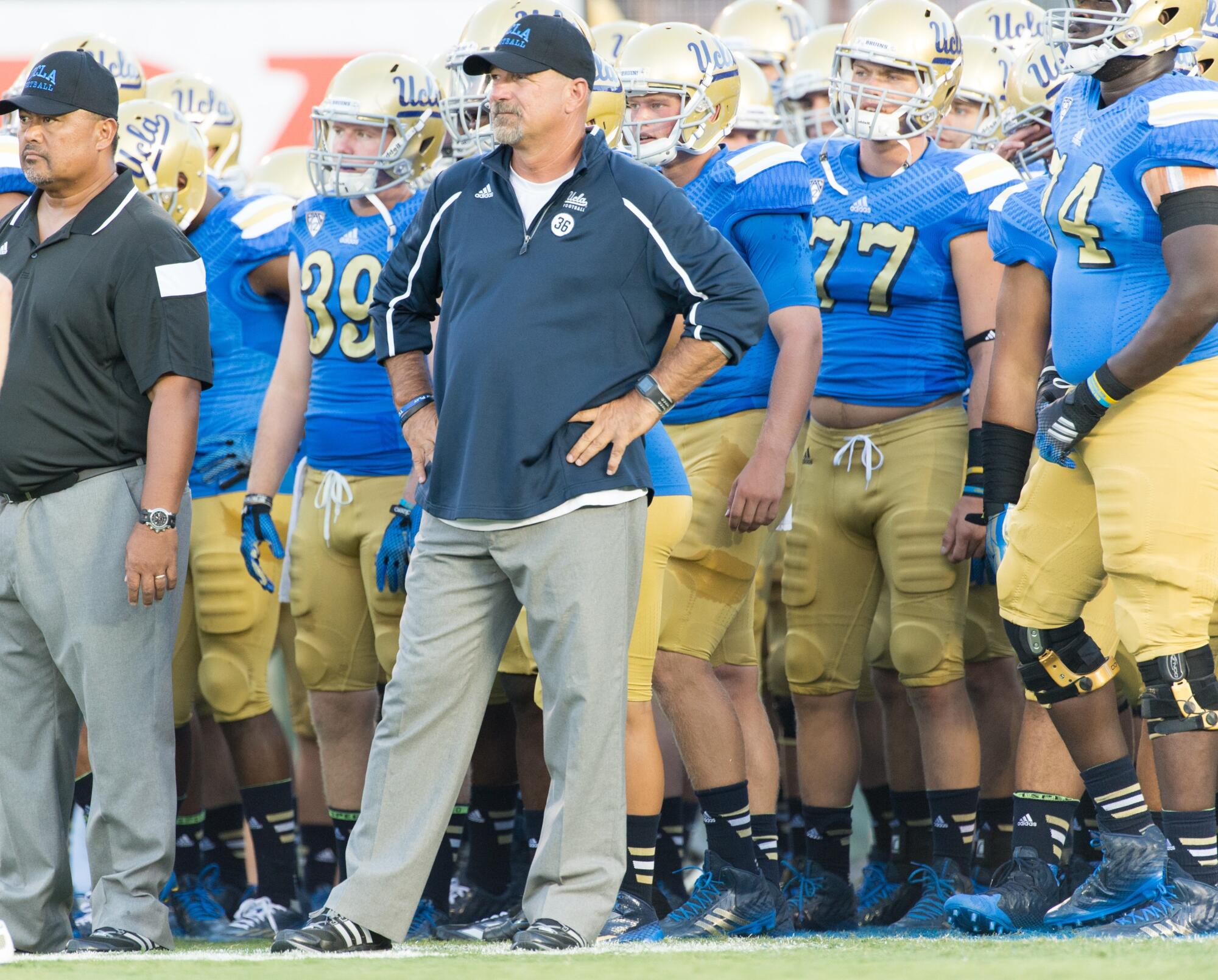Jerry Neuheisel and mentor Noel Mazzone reunite to jumpstart UCLA
They’re calling their favorite audible again.
One quarterback guru contacts the other, asking for help in creating a dynamic offense.
The answer is always yes. The results say as much about Jerry Neuheisel and Noel Mazzone’s devotion to one another as they do about their ability to mass-produce yards and points for UCLA.
“No matter what happens,” Neuheisel said in an interview with The Times, “as long as you’re around him you have a smile on your face.”
Noel Mazzone, then the offensive coordinator at UCLA, looks across the field during a game.
(Don Liebig / UCLA Athletics)
The latest call came from the longtime apprentice to his mentor.
With the Bruins sputtering toward an 0-4 start, Neuheisel spoke with Mazzone about possibly returning to Westwood to assist with the offense. Just like he routinely had when he was UCLA’s offensive coordinator a decade earlier, Mazzone cultivated the necessary intelligence, learning that Neuheisel would be promoted from tight ends coach to playcaller before Neuheisel did.
“He was in the car, I believe, the next morning and he was here that evening,” Neuheisel said, “and it was on to try to beat Penn State.”
Beat Penn State they did, reviving an offense and a team that have become the talk of college football. UCLA’s average of 40 points in its two victories has nearly tripled its previous output during that winless start, spawning reminders of the offense the Bruins ran under Mazzone with Neuheisel as a backup quarterback from 2012-15.
That was just the start of a winning combination.
Not long after they had parted ways at the end of their four seasons together in Westwood, Mazzone reached out to Neuheisel, convincing him to give up playing for the Obic Seagulls of Japan’s X League so that he could help Mazzone in 2017 during his second season as Texas A&M’s offensive coordinator.
“When he gave me the call and said, ‘We’re going to the SEC, we’re going to College Station, Texas,’ ” said Neuheisel, who had long known he wanted to become a coach, “I didn’t even ask questions. I got the next flight home.”
Quarterback Jerry Neuheisel looks to pass the ball during UCLA’s game against Texas Longhorns at AT&T Stadium on Sept. 13, 2014.
(Ronald Martinez / Getty Images)
After making the 22-hour drive from Los Angeles to College Station, Neuheisel stayed at a hotel for a week and a half while searching for a place to live — even though he hadn’t been formally hired.
All that mattered was that he was back with his mentor. Now they’re together again, only the roles have been reversed.
“It’s just the first time in my life he’s actually had to listen to all my ideas,” Neuheisel said with a chuckle, “so I have enjoyed the turning of the tables.”
It was only a few weeks ago that Mazzone reconnected with two other former UCLA quarterbacks.
Getting together with Brett Hundley and Mike Fafaul in the Phoenix area to watch some football the weekend that UCLA lost to Northwestern to fall to 0-4, Mazzone and his onetime players let Neuheisel know they were thinking about him.
“They sent a picture from the bar that they were watching us play,” Neuheisel said.
What they didn’t tell him was that they were already considering the possibilities for the 68-year-old Mazzone, who was then the offensive coordinator at Saguaro High in Scottsdale, Ariz.
“At the time, we weren’t doing so great,” Hundley said of the Bruins, “so we were joking that Mazzone would probably be back at UCLA.”
A coaching lifer, Mazzone had made more than 20 stops at the high school, college and NFL levels by the time he agreed to hop into his car and return for his second stint with the Bruins after the team replaced departed offensive coordinator Tino Sunseri with Neuheisel.
Several days later, after hurried preparations and some playcalling debut blunders such as Neuheisel fumbling with the button on his headset that allowed him to talk to his quarterback, UCLA scored on each of its first five drives on the way to a 42-37 victory over then-No. 7 Penn State that qualified as the upset of the college football season.
Jubilant players hoisted Neuheisel onto their shoulders in a scene reminiscent of his greatest moment playing for Mazzone and coach Jim Mora, when he came off the bench to lead a comeback victory over Texas in 2014.
UCLA quarterback Jerry Neuheisel, top, is carried off the field after UCLA’s 20-17 win over Texas on Sept. 13, 2014, in Arlington, Texas.
(Tony Gutierrez / Associated Press)
About a half hour after beating the Nittany Lions, his hair still soaked from the water players had sprayed into the locker room air, Neuheisel revealed what it meant to share this new memory with one of his favorite mentors.
“To have coach Mazzone here has been honestly one of the coolest things ever,” Neuheisel said. “To have him helping with the quarterbacks, to have us to be able to bounce ideas off of him, awesome. Awesome.”
In some ways, the circumstances weren’t that much different when they met.
Neuheisel was the new guy, just trying to prove himself.
In the fall of 2012, he was a freshman quarterback, wanting to show he belonged on the same campus where only a few months earlier his father, Rick, had been fired as the head coach. Mazzone was also a recent arrival after having been hired as part of Mora’s first UCLA staff.
“Jerry’s coming in and you’ve got Kevin Prince, Brett Hundley, Richard Brehaut — I mean, he’s walking into a quarterback room with some studs,” remembered Johnathan Franklin, the running back who would become UCLA’s all-time leading rusher by the end of that season. “All three have played before, and Brett Hundley obviously was a rock star.”
UCLA quarterback Jerry Neuheisel sits on the field before a game against Virginia at the Rose Bowl on Sept. 5, 2015.
(Jae C. Hong / Associated Press)
It was a unique kind of pressure for a legacy who had been born at UCLA Medical Center at a time when his father was a Bruins assistant coach, after having starred for his alma mater as a Rose Bowl-winning quarterback.
“I was just there trying to make the team,” Neuheisel said.
What became quickly apparent given his intrinsic savvy and inquisitive nature was that his longterm future would likely be on the sideline.
“Jerry, for sure, you could always tell he was gonna be a coach from Day One,” Hundley said. “It was like his Pops 2.0.”
Equally impressive was the shrewd offensive coordinator who was quick with a quip and an answer for any challenge a defense might present. Mazzone ran an offense short on plays and long on possibilities. He would explain why certain plays worked in given situations and make sure even the quarterback understood blocking schemes so that everyone appreciated each other’s roles.
“It’s pretty much, you get your best players in space and you make a play,” Franklin said of the overriding philosophy. “I remember he used to call the plays, and he’s like, ‘Man, one guy shouldn’t tackle you, so we’re not going to work on blocking that guy — that’s between you and him, you’ve got to make it happen.’ ”
UCLA offensive coordinator Noel Mazzone leans over on the sideline and looks across the field during a game.
(Don Liebig / UCLA Athletics)
UCLA won 29 games in its first three seasons with Mazzone running the offense and Neuheisel playing a reserve role, except for the September day in 2014 when he earned a megawatt spotlight.
With Hundley sidelined by an elbow injury against nationally ranked Texas, Neuheisel came off the bench and threw a 33-yard touchdown pass to Jordan Payton with three minutes left, rallying the Bruins to a 20-17 victory. His teammates hoisted him into the air and carried him off the field.
“I mean, unbelievable,” Mazzone said after the game. “Jerry went out and handled the situation better than anyone could. I mean, he really did an awesome job. Really proud for him.”
When he called a reporter after 8 o’clock Wednesday night, Neuheisel wasn’t done for the day. It was just a momentary respite from reviewing game video, several hours left to go before he could finally head home.
His schedule has become so crazed since his promotion that tight end Hudson Habermehl recently fielded a call from Neuheisel’s wife, Nicole, asking him to take an Uber Eats delivery order upstairs to Neuheisel’s office inside the practice facility.
Habermehl was happy to do it, a small thank-you gesture for the 33-year-old coach who has done so much for him and an offense that doesn’t resemble the one from earlier this season even though the Bruins are essentially running the same plays.
If it looks more like a Mazzone offense, that’s not by coincidence.
UCLA offensive coordinator Jerry Neuheisel hugs Bruins quarterback Nico Iamaleava during the Bruins’ win over Penn State on Oct. 4.
(Gina Ferazzi/Los Angeles Times)
“What made Noel’s offense so great and why I loved it is there was a utilization of space on the field,” Neuheisel said, “and I would say that is what we’ve been trying to emulate is trying to create space on the field and trying to create matchups for our players to have success.”
No one has benefited more than quarterback Nico Iamaleava, who has thrown for five touchdowns with no interceptions over the last two weeks while adding three rushing touchdowns. A previously inert running game has picked up considerable speed, averaging 253.5 yards in the victories over Penn State and Michigan State.
“It seems like there’s a new energy on offense,” Hundley said. “You know, it’s not like they got a whole new starting 11 out there. I mean, it’s the same guys that we were talking about in the beginning of the season, but now they’re putting Nico in a position to make plays.”
Habermehl said everyone’s playing freely and instinctively because Neuheisel explained the reasoning for each play and involved all position groups in offensive meetings to provide a universal understanding of concepts.
“When you coach guys,” Neuheisel said, “you need to let them in on the ‘why.’ I think it’s what I always appreciated when I was a player here and any good team I’ve been a part of.”
Neuheisel’s latest success is likely to earn him a permanent offensive coordinator job, if not a head coaching opportunity, next season. His old friend can probably expect a call asking if he’d like to be part of that staff, the answer a given.
“Wherever there’s ball,” Neuheisel said, “he’ll always find his way there.”

